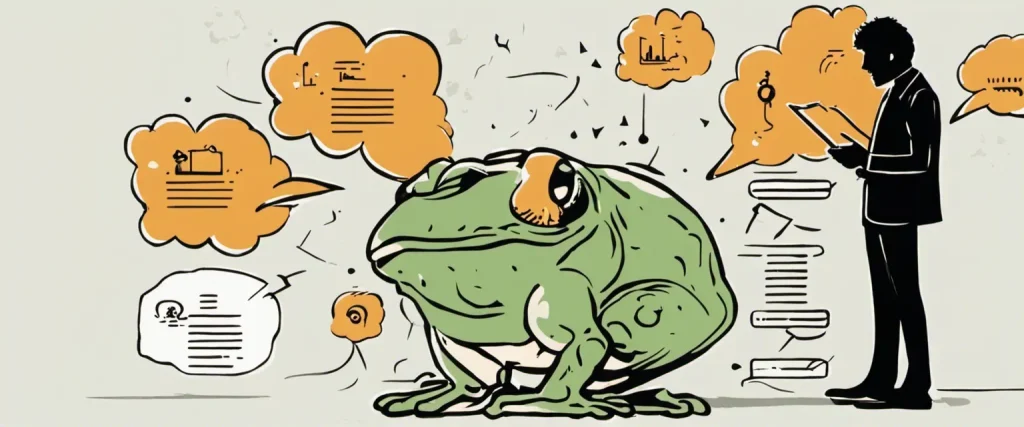In his compelling book, “Eat That Frog!,” Brian Tracy introduces readers to a powerful principle for boosting productivity and achieving their goals. Tracy, a highly esteemed motivational speaker and success expert, draws on decades of experience to elucidate the importance of overcoming procrastination and tackling the most challenging tasks first. In this summary, we will explore Tracy’s practical techniques, insightful strategies, and actionable advice that will undoubtedly revolutionize the way we approach our work and personal lives.
Chapter 1: Set the Table
Chapter 1 of “Eat That Frog!” by Brian Tracy is titled “Set the Table” and serves as a foundational lesson to help readers understand the importance of time management, productivity, and the concept of eating the biggest and most challenging task first.
The chapter begins by emphasizing the vital role that effective time management plays in achieving success and happiness in both personal and professional life. Tracy explains that the most successful people are those who are excellent at time management and consistently prioritize their tasks to tackle the most important ones first.
To illustrate the concept of prioritization, Tracy uses the metaphor of eating a frog. He states that if one has to eat a live frog, it’s best to do it first thing in the morning to get it over with and eliminate the anxiety of the task hanging over them throughout the day. In the context of productivity, the “frog” symbolizes the most challenging and impactful task that one tends to procrastinate on.
Tracy suggests that the key to effective time management and productivity is to always start with the biggest, most difficult, and most significant task of the day. By doing so, individuals can experience a surge of motivation, satisfaction, and accomplishment that propels them forward to tackle the rest of their tasks.
The chapter concludes by encouraging readers to analyze their current work habits and identify the frogs in their lives – the tasks they tend to procrastinate on or avoid. Tracy advises readers to commit to eating those frogs first thing in the morning and making it a daily habit to prioritize tasks based on their importance and impact.
In summary, Chapter 1 of “Eat That Frog!” outlines the significance of effective time management and productivity. Tracy introduces the concept of the “frog,” representing the essential task that needs to be tackled early in the day, and encourages readers to prioritize their tasks accordingly to achieve success and reduce procrastination.
Chapter 2: Plan Every Day in Advance
Chapter 2 of “Eat That Frog!” by Brian Tracy, titled “Plan Every Day in Advance,” emphasizes the importance of effective time management and how planning can significantly increase productivity.
Tracy begins by stating that planning is an essential habit for success. He suggests that by investing time in planning, individuals can save a significant amount of time later on. The key point he drives home is that planning every day in advance is one of the most crucial habits for achieving one’s goals.
The chapter outlines six steps for effective daily planning. The first step is to take a few minutes at the end of each day to make a plan for the following day. This allows individuals to enter the next day with purpose and direction. The second step is to make a list of tasks, starting with the most important ones. According to Tracy, focusing on the most crucial tasks first helps individuals feel a sense of accomplishment and motivates them to continue to tackle their to-do list.
The third step involves organizing the list by priority. Tracy advises using the “ABCDE” method, where “A” represents tasks with significant consequences, “B” represents tasks with minor consequences, and so on. By prioritizing tasks based on their importance and impact, individuals can ensure they devote their time and energy to what matters most.
The fourth step is to set deadlines for each task. This creates a sense of urgency and allows individuals to remain focused and avoid procrastination. The fifth step is to make a plan for each day, allocating specific time slots to different activities. This aids in maximizing efficiency and avoiding time wastage.
Finally, the sixth step is to review and update the plan regularly. By making adjustments and assessing progress, individuals can adapt to changing circumstances and stay on track towards their goals.
In conclusion, Chapter 2 highlights that effective daily planning is a crucial habit for success. By investing time in planning, organizing tasks, setting deadlines, and making a detailed plan, individuals can enhance their productivity and ultimately achieve their desired outcomes.
Chapter 3: Apply the 80/20 Rule to Everything
Chapter 3 of “Eat That Frog!” by Brian Tracy introduces the concept of the 80/20 Rule, also known as the Pareto Principle. This principle states that 20% of our efforts often result in 80% of our desired outcomes, while 80% of our efforts only yield 20% of the desired results. Tracy emphasizes that by understanding and applying this principle, individuals can maximize their productivity and effectiveness in all areas of their lives.
The chapter starts with an explanation of how the 80/20 Rule applies to time management. Tracy highlights that focusing on the most important tasks that contribute to the greatest outcomes is crucial for success. By identifying and prioritizing the vital few tasks that bring the most value, individuals can significantly amplify their productivity.
Moreover, Tracy discusses the significance of the 80/20 Rule in regards to personal relationships and identifies how a small number of close relationships can contribute significantly to one’s happiness and success. He advises readers to invest time and effort in nurturing and cultivating these essential relationships, rather than spreading themselves thin or wasting energy on less meaningful connections.
Tracy further demonstrates the application of the 80/20 Rule in financial matters, suggesting that a few specific strategies or investments can lead to the majority of financial gains. He encourages readers to allocate their resources wisely, considering where their efforts and investments are most likely to yield the highest returns.
In summary, Chapter 3 of “Eat That Frog!” highlights the importance of applying the 80/20 Rule to all areas of life. By focusing on the most critical tasks, nurturing key relationships, and directing resources towards high-return opportunities, individuals can achieve greater productivity and success in their personal and professional lives.
Chapter 4: Consider the Consequences

Chapter 4 of “Eat That Frog!” by Brian Tracy focuses on the importance of considering the consequences of our actions and prioritizing accordingly. The chapter begins by highlighting the concept of the “80/20 Rule,” also known as the Pareto Principle, which states that 20% of our activities contribute to 80% of our results. Tracy urges readers to identify and focus on the tasks that fall under this crucial 20%.
Tracy emphasizes the significance of considering the potential long-term consequences of our actions. He encourages readers to analyze every task and question whether it will help them achieve their goals or if it is merely a distraction. This involves looking at the effect each activity will have on their future, as well as considering the negative consequences of procrastinating or not prioritizing effectively.
One of the key principles discussed in this chapter is “short-term pain, long-term pleasure.” Tracy suggests that we should be willing to endure short-term discomfort, such as tackling challenging tasks first thing in the morning, in order to experience the long-term rewards and satisfaction that come from accomplishing important goals. By considering the long-term consequences, we can ensure that we are making choices that align with our values and desired outcomes.
Tracy emphasizes the need for discipline and self-control when it comes to prioritizing tasks. He advises readers to consistently evaluate their actions and make adjustments to ensure they are on the right path towards achieving their goals. The chapter concludes with the reminder that by considering the consequences of our choices and consistently prioritizing wisely, we can effectively manage our time and achieve greater success and fulfillment in our lives.
Chapter 5: Practice Creative Procrastination
In Chapter 5 of Eat That Frog! titled “Practice Creative Procrastination,” Brian Tracy introduces the concept of selectively choosing which tasks to focus on and which to delay or eliminate altogether. He suggests that successful people are often able to identify their most important goals and prioritize their time accordingly.
Tracy explains that by practising “creative procrastination,” individuals can actively avoid wasting time on low-priority tasks that do not contribute significantly to their goals. This approach involves deciding to postpone or eliminate non-essential activities in order to create a clearer focus on tasks that truly matter.
The author provides several strategies to help readers effectively practice creative procrastination. First, he advises defining the specific outcomes or results that are most important to achieve. By having a clear vision of what you want to accomplish, it becomes easier to identify which tasks align with those goals and which can be delayed.
Tracy emphasizes the significance of saying “no” to activities and demands that do not contribute to one’s overall goals. Learning to decline less important tasks enables individuals to devote more time and energy to what truly matters.
Additionally, he suggests using technology, such as email filters and autoresponders, to manage distractions and reduce time wasted on non-essential communications. By leveraging these tools, individuals can stay focused on their high-priority tasks.
Finally, the author advises readers to delegate tasks that can be handled by others. By effectively delegating work, individuals free up their own time to concentrate on tasks that require their unique skills or expertise.
In summary, Chapter 5 of Eat That Frog! provides insights into the practice of creative procrastination as a means to prioritize one’s tasks and effectively focus on high-impact activities. By consciously choosing to delay or eliminate non-essential tasks, individuals can achieve greater efficiency and productivity towards their most important goals.
Chapter 6: Focus on Key Result Areas
Chapter 6 of “Eat That Frog!” by Brian Tracy focuses on the concept of Key Result Areas (KRAs). Tracy explains that KRAs are the few essential things in each area of your life or work that can have the greatest impact on your results. He emphasizes the importance of identifying and focusing on these key areas to maximize productivity and achieve your goals.
To begin, Tracy suggests that you evaluate your current responsibilities and determine the specific tasks or activities that contribute the most to your overall success. By identifying these key areas, you prioritize the tasks that will yield the most significant results and minimize unnecessary time spent on less essential activities.
Tracy introduces the 80/20 Rule, also known as the Pareto Principle, where 20% of your activities generate 80% of your results. He advises readers to apply this principle to their daily lives and focus on the 20% of their tasks that will have the most impact on their desired outcomes.
Once you have identified your KRAs, Tracy recommends dedicating the majority of your time and energy to working on them. By doing this, you create a habit of focus and avoid getting caught up in minor tasks or distractions that might hinder your progress.
Tracy also encourages readers to establish goals within each KRA and break them down into smaller, measurable tasks. This allows you to track your progress and stay motivated by celebrating each milestone achieved.
In conclusion, Chapter 6 of “Eat That Frog!” emphasizes the importance of identifying your Key Result Areas and focusing on the essential tasks that will yield the greatest results. By applying the 80/20 Rule and breaking down goals into actionable steps, you can increase your productivity and move closer to achieving your desired outcomes.
Chapter 7: Obey the Law of Forced Efficiency
Chapter 7 of the book “Eat That Frog!” by Brian Tracy is titled “Obey the Law of Forced Efficiency.” In this chapter, Tracy emphasizes the importance of increasing productivity and getting more done in less time through the application of the Law of Forced Efficiency.
The Law of Forced Efficiency states that, “There is never enough time to do everything, but there is always enough time to do the most important thing.” Tracy advises readers to identify the key tasks that will have the greatest impact on their goals and prioritize those above all else. By focusing on these crucial tasks, one can dramatically increase their productivity and effectiveness.
Tracy provides several techniques to help individuals implement the Law of Forced Efficiency. Firstly, he suggests that readers should ask themselves the vital question, “What is the most valuable use of my time right now?” This question helps prioritize tasks and prevents wasting time on less important activities. Secondly, Tracy advises creating detailed plans and organizing tasks using a to-do list in order to clearly define objectives and stay on track.
Additionally, Tracy introduces the concept of the ABCDE Method, which involves categorizing tasks into five levels of priority, labeled A to E. A tasks are the most significant, while E tasks are tasks that can be eliminated altogether or delegated to others. By distinguishing between these levels of priority, individuals can allocate their time and effort more effectively.
Furthermore, Tracy advocates for avoiding procrastination and taking immediate action on important tasks. He recommends that readers tackle their most challenging or demanding tasks first, as completing these early in the day can provide a sense of accomplishment and motivation.
In summary, Chapter 7 of “Eat That Frog!” emphasizes the necessity of prioritizing and focusing on the most important tasks. By understanding and implementing the Law of Forced Efficiency, individuals can increase their productivity, achieve their goals, and ultimately make the most of their time.

Chapter 8: Prepare Thoroughly Before You Begin
Chapter 8: Prepare Thoroughly Before You Begin of the book Eat That Frog! by Brian Tracy emphasizes the critical importance of effective preparation before starting any task or project. The chapter begins by stating that proper preparation is essential for success in any endeavor.
Tracy highlights three key aspects of preparation: setting clear goals, gathering all necessary information, and organizing your materials. He points out that setting clear and specific goals is the first step towards accomplishment. By defining exactly what needs to be achieved, you can increase your motivation and focus, guiding your actions towards the desired outcome.
Next, Tracy emphasizes the significance of gathering all the information relevant to the task. Whether it’s research, data, or any other relevant materials, having all the necessary information on hand helps in making informed decisions and performing efficiently. Additionally, he stresses the importance of organizing these materials in a logical and accessible manner, allowing for easy retrieval when needed.
Tracy then introduces the concept of sequencing, which involves breaking down big tasks into smaller, manageable steps. He suggests arranging tasks in their order of importance or reliance, ensuring that you tackle the vital elements first. This allows for smoother progress and minimizes the chances of wasting time on less crucial aspects.
Furthermore, the chapter highlights the significance of visualization, as well as mental and physical rehearsal. Tracy explains that visualizing the successful completion of a task or imagining yourself performing it flawlessly can enhance your confidence and prepare your mind for success. He encourages readers to mentally rehearse challenging tasks, which can reduce anxiety and boost performance.
Ultimately, Chapter 8 stresses the importance of thorough preparation as a crucial factor in achieving success. By setting clear goals, gathering information, organizing materials, sequencing tasks, and using visualization techniques, individuals can enhance their productivity, efficiency, and overall performance in any endeavor.
After Reading
In conclusion, “Eat That Frog!” by Brian Tracy is an insightful and practical guide to overcoming procrastination and improving productivity. Tracy emphasizes the importance of prioritizing tasks, focusing on high-value activities, and taking immediate action. He provides valuable strategies and techniques, such as setting clear goals, breaking tasks into smaller steps, and leveraging the power of momentum. With his motivational and actionable advice, Tracy empowers readers to tackle their biggest challenges head-on and achieve greater success. By implementing the principles outlined in this book, individuals can develop a mindset of discipline and decisiveness that will positively impact their personal and professional lives. “Eat That Frog!” is a must-read for anyone seeking to maximize their productivity and achieve their goals.
Book Recommendation: 5 Powerful Reads to Transform Your Life
1. The 7 Habits of Highly Effective People” by Stephen R. Covey
Stephen R. Covey’s classic, “The 7 Habits of Highly Effective People,” is a must-read for personal growth and success. Covey shares powerful insights on how to embrace positive change, develop a proactive mindset, and cultivate habits that lead to long-term success. The book delves into topics such as effective communication, time management, and interpersonal relationships, making it an essential guide for anyone seeking personal and professional growth.
2. Getting Things Done” by David Allen
In “Getting Things Done,” David Allen presents a practical and effective system for managing tasks, projects, and commitments. Allen’s methodology provides a clear roadmap to enhance productivity, reduce stress, and achieve a state of flow. By mastering the art of capturing, organizing, and completing tasks, readers can streamline their workflow and reclaim control over their time and energy.
3. Atomic Habits” by James Clear
Atomic Habits” by James Clear offers a fresh perspective on creating meaningful change by focusing on small habits. Clear explains how tiny, consistent actions can accumulate into remarkable results over time. By understanding the science of habit formation and employing practical strategies, readers can reshape their behavior and make positive habits stick. This book is a game-changer for anyone looking to break bad habits, build new ones, and transform their lives.
4. Deep Work” by Cal Newport
In the age of constant distractions and digital overwhelm, Deep Work” by Cal Newport provides valuable insights on how to focus deeply and produce high-quality work. Newport explores the concept of deep work, which involves the ability to concentrate without distraction on cognitively demanding tasks. By adopting Newport’s strategies, readers can unlock their productivity potential, achieve better results, and cultivate a sense of fulfillment in their professional and personal lives.
5. The Power of Now” by Eckhart Tolle
The Power of Now” by Eckhart Tolle is a spiritual guidebook that imparts essential wisdom for living in the present moment. Tolle teaches readers how to let go of past regrets and future anxieties, enabling a state of joy, peace, and profound clarity. This transformative book reminds us of the power of mindfulness and helps us transcend ego-based thinking to experience true fulfillment in our lives.
These five books offer a comprehensive toolkit for personal growth and lifelong success. Each one delves into different aspects of self-improvement, encompassing topics such as effective habits, task management, deep focus, spiritual well-being, and more. Together, they form a powerful collection that can empower individuals to lead a more fulfilling and purposeful life.



